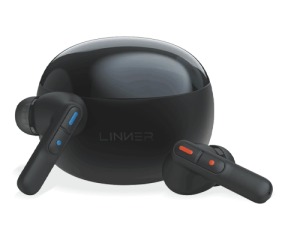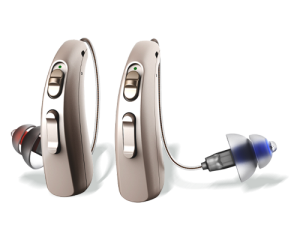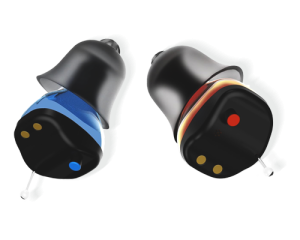- Cost per pair: $400
- Dimensions: 25 millimeters (mm) X 22 mm X 17 mm
- Weight: 6 grams (g)
- Type of hearing aid: In-the-ear (ITE)
- Type of hearing loss: Mild to moderate
- Battery type: Rechargeable
- Bluetooth capabilities: Hands-free calling, streaming, app connection
Linner Hearing Aids Review (2025): Expert Tested
Key Takeaways
- Linner hearing aids are comfortable, easy to use, and affordable over-the-counter devices.
- A pair of Linner hearing aids costs $100–$500.
- All Linner hearing aids are rechargeable and come with a 45-day trial period and one-year warranty.
- Although the Linner Mars and Linner Nova offer affordable Bluetooth streaming, their limited battery life of eight to 10 hours may be short for some people.
- OTC hearing aids like Linner are only appropriate for adults with mild to moderate hearing loss.
The best hearing aids can be expensive, often retailing for more than $1,000 per pair. Because health insurance providers, including Medicare and private companies, typically don’t pay for hearing aids, many people have to pay out of pocket for hearing loss treatment. If you’re looking to spend $500 or less, Linner hearing aids could be a good option. We tested Linner hearing aids and were impressed by their comfort, quality, and ease of use.
Despite their affordable prices, some Linner hearing aids come with premium features like app adjustments, Bluetooth streaming, and hands-free calling. But these conveniences come with a tradeoff—poor battery life. If you aren’t interested in Bluetooth capabilities, you’ll appreciate the all-day battery life of Linner’s simpler devices.
Our Linner hearing aids review will outline the pros and cons of each model, highlight our testing experiences, and compare Linner devices to the competition, so you can choose the best model for you.
Linner Mars
Our expert take on the Linner Mars hearing aid
The Linner Mars is a large ITE hearing aid with quick adjustments, including balance, directionality, and bass and treble sounds.
These features are usually found in more expensive hearing aids, but the Linner Mars retails for $400. In fact, the Linner Mars is the most affordable hearing aid with hands-free calling, followed by the $499 HP Hearing PRO.
The tradeoff here is a short 8-hour battery life. If you use Bluetooth to stream audio or handle phone calls, expect the battery to drain even faster. The portable charging case holds up to three charges, but you would have to recharge the Linner Mars at least once per day due to its limited battery life.
“My opinion on devices that have less than 18 hours of battery life is that they’re obsolete,” said Rachel Magann Faivre, AuD, audiologist and owner of ASH Audiology in Oklahoma. “Our brains hear sounds 24/7. They’re not like our eyes that go to sleep at night. In order for your brain to hear well when wearing hearing aids, it really needs to hear sounds during all waking hours.”
Faivre said that people may feel like they’re not hearing well if they use hearing aids sporadically. “Their brains aren’t used to hearing all those sounds. Every little background noise is overwhelming, and the brain has a hard time distinguishing speech from noise.”
We think the Linner Mars could work for people with mild hearing loss who don’t mind frequently recharging the device. But, as Faivre said, if the device doesn’t seem to improve your hearing, you may need hearing aids you can wear all day, without interruption, to get the full benefits of using hearing aids.
The Mars’ main competitor, the HP Hearing PRO, also has an eight-hour battery life. To get hands-free calling in an over-the-counter (OTC) device with an 18-hour battery life, you would need to spend at least $1,398 for the Audicus Wave 2. If you don’t need hands-free calling but want a device that streams Bluetooth audio, a more affordable option is the $499 Elehear Alpha Pro, which has a maximum battery life of 20 hours.
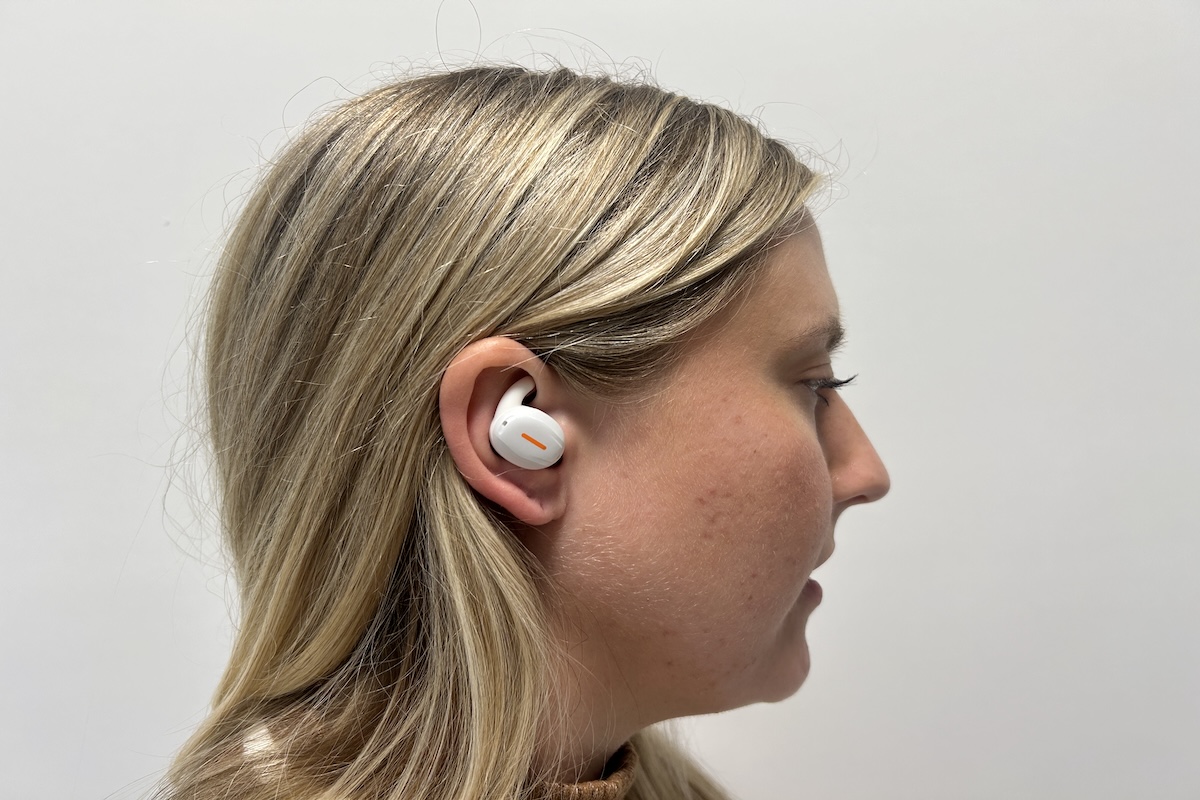
Our experience using Linner Mars
Overall, our testing team had positive experiences with the Linner Mars. Setup was fast and easy, and the manual comes with step-by-step instructions for the first month of use so you can get used to how they feel and learn how to adjust them.
Testers said the Linner HA app was intuitive and easy to use whenever they wanted to change volume, listening modes, or settings. The buttons on the hearing aids themselves were less intuitive. “I couldn’t figure out how to use the multi-use controls on the hearing aids,” one tester said. “The instructions said to click the button on the hearing aid twice to make the volume louder, but every time I tried to do so, it didn’t work.”
The only other criticism testers shared was that the Linner Mars hearing aids seemed quite large. “They were comfortable, though, and I appreciate that they come with different-sized ear tips,” one tester said.
Our testing team was happy with the sound quality of the hearing aids, especially when streaming audio via Bluetooth. “I was really impressed with the Bluetooth. The sound quality was almost as good as my Apple AirPods.”
Linner Nova
Our expert take on the Linner Nova hearing aid
The Linner Nova hearing aids look like Apple AirPods but come in three colors: white, blue, and black. The white and blue models cost $300, and the black version costs $500. A Linner representative told us the black version is the limited-edition Nova Deluxe that uses a MEMS speaker for better sound quality.
ITE-style Nova hearing aids are the most affordable Bluetooth hearing aids on the market. They use Bluetooth for app-base adjustments and audio streaming but don’t offer hands-free calling. Like the Mars hearing aids, Nova devices have a very short battery life of eight to 10 hours. They’ll work best if you have time to charge them throughout the day.
Linner Mercury
Our expert take on the Linner Mercury hearing aid
The Linner Mercury is a basic and affordable RIC hearing aid with a rechargeable battery that lasts up to 20 hours—twice the battery life of the Nova. It doesn’t connect to a smartphone app, so settings like directionality can’t be adjusted. You can toggle through three preset listening modes (default, high frequency, and low frequency) and change the volume by pressing buttons on the hearing aid.
The Linner website says the Mercury can treat mild to severe hearing loss, but the FDA recommends OTC devices for mild to moderate hearing loss only. According to the American Speech-Language-Hearing Association, people with moderate hearing loss may not hear certain, or all, frequencies until they reach 41–55 dB louder than normal. For people with moderately severe hearing loss, that increases to 56–70 dB. If your hearing test indicates you have moderately severe hearing loss, a prescription hearing aid is best.
The closest competitor of the Linner Mercury is the Elehear Alpha, which costs $100 more and features wind suppression for a better outdoor listening experience. The Elehear Alpha’s portable charger holds seven full charges compared to three full charges for the Linner Mercury.
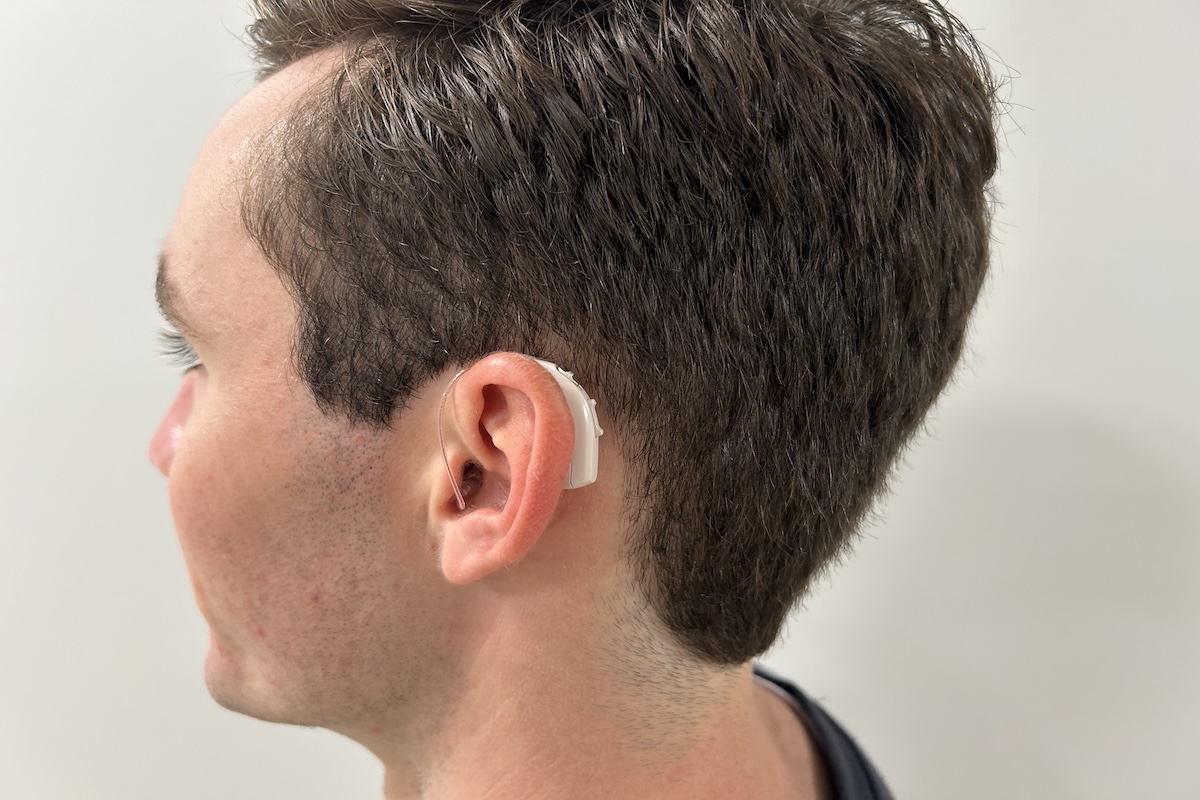
Our experience using Linner Mercury
The Linner Mercury user guide prompted our tester team to download an app even though this hearing aid isn’t compatible with Bluetooth. The app is essentially a customer service portal and doesn’t allow you to control the hearing aids.
Our testing team noticed the wire that connects the receiver to the body of the hearing aid comes in one size only. Receiver-in-canal hearing aids should include wires in different lengths and a sizing tool that helps you choose the best one. If the wire isn’t the right size, it can make the body of the hearing aid fit too high or too low behind the ear.
On the plus side, testers say the Linner Mercury hearing aids are lightweight and comfortable. “I quickly forgot I was wearing them,” one tester said. Testers also praised the intuitive charging case that’s similar to the ones used for popular earbuds like AirPods.
Linner Venus
Our expert take on the Linner Venus hearing aid
Linner Venus hearing aids are ITE but are much smaller than the Mars and Nova. They have a rechargeable battery with a generous 24-hour lifespan. Like all other Linner hearing aids, Venus devices come with a portable charging case for added convenience.
There are no buttons on these hearing aids. To change listening modes or volume, tap the flat part of the hearing aid. You can independently adjust the volume of the left and right hearing aid, but no other adjustments are possible because Venus hearing aids don’t connect to a phone app.
The three listening programs are designed for one-on-one conversations, noisy environments, and road vehicles. The hearing aids announce the name of each program as you scroll through them, which we prefer instead of the series of beeps that other hearing aids use to identify their programs.
The Venus hearing aids aren’t water resistant, so avoid wearing them in the rain or during a workout.
Linner Saturn
Our expert take on the Linner Saturn hearing aid
Linner Saturn hearing aids are among the most affordable hearing aids on the market at $100 per pair. They only treat mild hearing loss, so consider visiting an audiologist for a hearing test to confirm that these could work for you.
We prefer the Linner Saturn over the Audien Atom, another popular hearing aid that also costs $100. The Saturn comes with a portable charging case that holds three full charges, and the Atom uses a desktop charger. It’s also easier to adjust the Saturn due to its push-buttons— the Atom must be removed from the ear and adjusted with a small screwdriver.
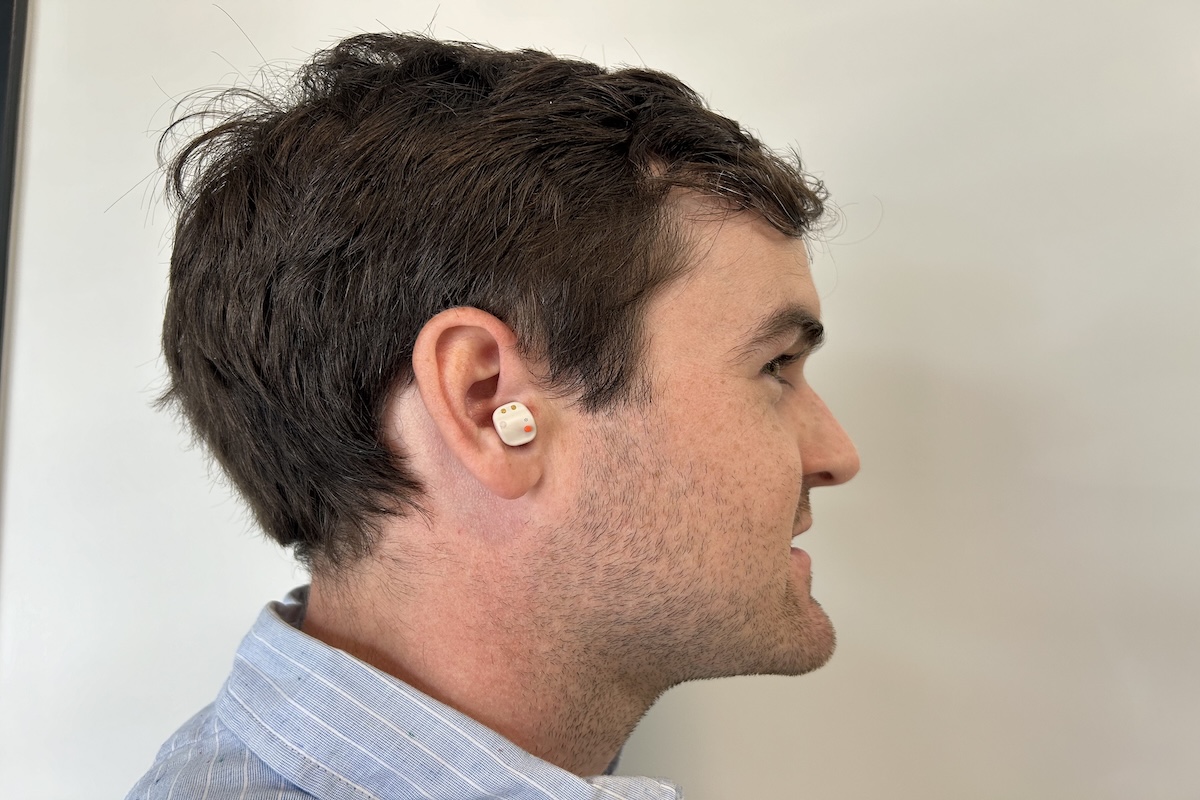
Our experience using Linner Saturn
According to the Linner Saturn user manual, users must scan a QR code and download an app. But this led to confusion among our testing team because, as it turns out, the Saturn devices can’t connect to an app because they don’t have a Bluetooth chip.
“The app doesn’t do anything other than connect you with customer service and host the instruction manual,” one tester said. “The app instructs you to connect to Bluetooth, but then the hearing aids don’t appear as a device. It was misleading.”
Testers also had to be careful not to accidentally push the volume button when inserting the hearing aid into their ear. Once it was successfully inserted, testers said it was very comfortable. “I got used to the way it fits in my ear very quickly,” one said.
Pros and cons of Linner hearing aids
Pros:
- Affordable; all models cost less than $500
- Good sound quality when streaming Bluetooth
- Adjustable settings in app-compatible devices
- Some batteries last 20–24 hours
- Comfortable designs
- 45-day trial period
- One-year warranty
Cons:
- Some batteries only last eight to 10 hours
- Not all devices are waterproof or water-resistant
- Instruction manual says to download an app for non-Bluetooth devices, which may be confusing
How to purchase Linner hearing aids
Linner hearing aids can be purchased over the counter. In other words, no prescription is required. Over-the-counter hearing aids are intended for people at least 18 years old who have mild to moderately severe hearing loss.
If you do not want to visit a hearing specialist for a professional hearing test, take an online hearing test to confirm you are experiencing hearing loss before you buy OTC hearing aids like the ones from Linner. Even though OTC hearing aids do not require a test or prescription, it’s important to complete an assessment before purchasing and using a hearing aid device.
Linner hearing aids are available online through the Linner website, Amazon, Best Buy, and Walmart. They are not currently available in-store at Best Buy or Walmart, but you can arrange for in-store pickup.
How much do Linner hearing aids cost?
Linner hearing aids cost $100–$500, with an average cost of $300 per pair. Shipping is free.
Like all hearing aids, Linner devices are HSA and FSA eligible. Hearing aids aren’t covered by original Medicare (Part A and Part B) but may be covered by your Medicare Advantage plan (Part C). Medicaid coverage varies by plan.
Linner contact and payment information
Linner customer service
You can reach Linner customer service by:
- Phone: Call 888-819-1558
- Chat: Chat via the bottom right corner of the website
- Email: support@linnerlife.com
- Online form: Submit a contact form on the website
Linner hearing aids have a one-year warranty and come with a 45-day trial period.
Payment options
Linner accepts Visa, Mastercard, American Express, Discover, Diners Club, Elo, JCB, and Union Pay credit cards, as well as PayPal, Shop Pay, Amazon Pay, Google Pay, and Venmo. Financing is available through Affirm and Shop Pay.
What to consider before buying hearing aids
- Cause of hearing loss: Consider visiting an audiologist for a physical exam before purchasing hearing aids. Hearing loss can be caused by wax buildup, which can be treated without hearing aids. Establishing a relationship with a local audiologist is also a good idea for post-purchase care because they can help you make sure the device is fitted correctly.
- Degree of hearing loss: Your degree of hearing loss indicates how loud sounds must be amplified before you can hear them. Over-the-counter hearing aids, like those from Linner, have limited amplification abilities and aren’t best for people with severe or profound hearing loss.
- Budget: Linner hearing aids are a good choice if you’re looking to spend less than $500, but you may be happier with the battery life, features, and sound quality of more expensive devices.
- Style preferences: Some hearing aids fit behind the ear, while others look like large earbuds. Others fit discreetly in the ear canal for a nearly invisible look. Choose a style that gives you confidence, keeping in mind that larger-size hearing aids can include more hardware for technology, like Bluetooth streaming.
- Features: Consider what you expect your hearing aids to do. Some people enjoy the convenience of Bluetooth hearing aids because they connect to an app for extra adjustments, stream audio from Bluetooth-enabled devices, and may even allow for hands-free calling. Other popular features include wind reduction and directional focus.
Learn more in our guide to choosing hearing aids.
Compare Linner hearing aids, as of 2025
| Cost per pair | $400 | $300–$500 | $300 | $200 | $100 |
| Type of hearing aid | ITE | ITE | RIC | ITE | ITC |
| Degree of hearing loss | Mild to moderate | Mild to moderate | Mild to moderate | Mild to moderate | Mild |
| Max. battery life | 8 hours | 8–10 hours | 20 hours | 24 hours | 16–20 hours |
| Bluetooth streaming | Yes | Yes | No | No | No |
| Hands-free calling | Yes | No | No | No | No |
Bottom line
Overall, Linner hearing aids performed well during our testing. But we would like to see a better battery life in the brand’s Bluetooth-enabled devices, the Mars and Nova. An eight-hour battery doesn’t allow for uninterrupted wear, which could be inconvenient. Otherwise, Linner hearing aids are a competitive option for the price.
Frequently asked questions
Based on our experience testing Linner hearing aids, we believe they’re a good option for people on a budget. They feel comfortable and lightweight, and the Bluetooth-enabled devices connect to an easy-to-use app for extra control. Testers were also impressed by the hearing aids’ sound quality. But the extremely short battery life is a concern for the Mars and Nova devices.
Depending on the model, Linner hearing aids last eight to 24 hours on a single charge. As for the lifespan of the device itself, many hearing aids last for about five years. Regularly cleaning your hearing aids can help extend their lifespan.
Linner works with different manufacturers, including Austar Hearing Science and Technology, Xround Limited, and Guangdong Transtek Medical Electronics Co., Ltd.
Questions? Email us at reviewsteam@ncoa.org.
Sources
- Federal Register. Medical Devices; Ear, Nose, and Throat Devices; Establishing Over-the-Counter Hearing Aids. Aug. 17, 2022. Found on the internet at https://www.federalregister.gov/documents/2022/08/17/2022-17230/medical-devices-ear-nose-and-throat-devices-establishing-over-the-counter-hearing-aids
- American Speech-Language-Hearing Association. Degree of Hearing Loss. Found on the internet at https://www.asha.org/public/hearing/degree-of-hearing-loss/



